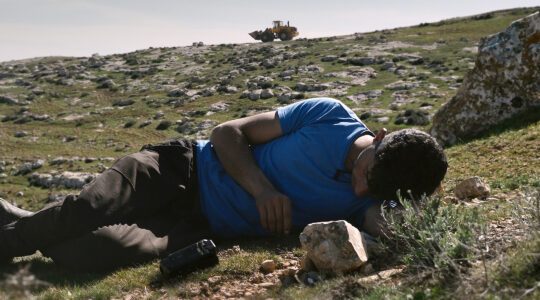In the immediate aftermath of the flotilla confrontation, pundits and analysts began asking tough questions about whether the mission had been plagued by intelligence and operational failures. While those questions aren’t going away, a new issue has emerged: Did the Israelis botch the image battle?
The New York Times has published a general backgrounder on the battle for YouTube:
When Israeli commandos attacked the so-called Freedom Flotilla, both sides were well armed — with video cameras — and both sides have released a blizzard of video clips as evidence that the other side was the aggressor in the conflict on Monday, which left nine activists dead.
A frame from an Israeli Defense Forces video of the clash on an international flotilla on Monday.
Once again, the political power of the moving picture is on display, as it was last year when a video showing the death of a young protester in Iran, Neda Agha-Soltan, became a symbol of resistance in that country.
The flotilla videos have proved a popular draw online, with one from the Israel Defense Forces attracting more than 600,000 views on YouTube. Scenes from both perspectives have been shown in a continuous loop on television news programs all over the world, stirring public outrage.
But what is missing so far from the flotilla clips on both sides is context: it is difficult to establish the sequence of events or, more simply, to determine who attacked first. The videos have made it all the more murky.
But this isn’t a case of the Times picking on Israel — the harshest criticisms are coming from friends.
Here’s what Malcolm Hoenlein, the executive vice-chairman of the Conference of Presidents of Major American Jewish Organizations, told The Jerusalem Post:
“There’s a lot of anger about the hasbara [public diplomacy], how it was handled,” said Malcolm Hoenlein, executive head of the Conference of Presidents of MajorAmerican Jewish Organizations.
“Why did it take so long to get the films [of the ship-board violence] out? It appears [the soldiers] weren’t prepared for what they found, even though they knew what they were going to find.”
The Jewish community supports Israel, Hoenlein said. “People see the overkill against Israel, the biased reporting. Of course, every time the UN gets involved, Jews automatically [turn] against it.”
But, he lamented on Tuesday, “We’re only now coming to terms with the facts.” And that’s a shame, because “the facts make the case for Israel.”
An unnamed Jewish communal official was even harsher in criticizing the delays in releasing IDF video suggesting that Israeli troops had been attacked first:
“The Jewish world gets its information the same way everyone else does,” the official continued. “At four in the morning [the hour of the boarding], we could have been given the information. But we weren’t, because your generals are bone-headed, like the generals in the 19th century who didn’t understand that machine guns had made cavalry obsolete. The Jewishcommunities are paying a price for this mistake.”
The Post’s editor, David Horovitz, argues that whoever decided to hold back on releasing the video “should be relieved of their responsibilities, effective immediately”:
Let there be no doubt about this. The failure to release in good time the video evidence that showed exactly why Israeli commandos resorted to live fire aboard the Mavi Marmara, the video evidence that would emphatically have affected the way the incident was perceived around the world, was not accidental. Neither was it the consequence of some kind of bureaucratic snafu. Nor was it held back for technical reasons.
It was the result of a decision. The officials, in their various competing, conflicting, inadequate propaganda hierarchies, actively chose, after consultation, not to release it. (The Jerusalem Post’s military correspondent Yaakov Katz provides some of the specifics elsewhere on these pages.)
Some of their considerations are not beneath contempt. There was a legitimate concern, for instance, that the footage, showing colleagues in such trouble, might prove demoralizing for Israeli troops. And some of their considerations are utterly contemptible, including the scandalous parochial obsession with local TV – the insistent, misguided desire to hold back dramatic material until late in the Israeli day, so that as many people as possible here will see it fresh on the 8 p.m. Hebrew nightly news.
These, and all other considerations, in a competent official media hierarchy that recognized the urgent imperative to disseminate the footage, would have been immediately set aside. Even allowing generous time for processing and editing the material, the footage could have been flashing across TV screens worldwide by our breakfast time, before news of the entire incident was even beginning to permeate. Would it have completely transformed the way the incident was reported and understood? No. Would it have greatly helped Israel’s case? Unquestionably.
This line of criticism should come as no surprise. Israeli pundits and pro-Israel activists are often quick to point out Israel’s PR missteps. And, in the case of delaying the release of these videos, it’s hard to dispute that Israel’s military brass messed up.
But the point only gets you so far.
For starters, even when Israel’s version of events sinks in, and you accept that the IDF troops were not the attackers, but the ones being ambushed, you’re still left with this uncomfortable conclusion: This was a poorly planned mission that put the lives of Israeli soldiers and people on the boat in danger.
More importantly, however, the information battle is quickly moving beyond questions of which side fired first. Just take a look at the editorial in Wednesday’s Times:
… The questions raised by the confrontation — and there are many — demand an immediate and objective international investigation.
Why did Israel, which has blocked some ships but allowed others to pass, decide to take a stand now? Did it make a real effort to find a compromise with Turkey, which sanctioned the flotilla? Israel has a right to stop weapons from going into Gaza, but there has been no suggestion that the ships were carrying a large cache.Was boarding, especially in the dark, the only means of stopping the ships? What happened once Israeli forces got on board? The Israeli Defense Forces have distributed a video showing that the commandos were attacked. Why weren’t they better prepared to defend themselves without using lethal force?
There is a bigger question that Israel — and the United States — must be asking: Is the blockade working? Is it weakening Hamas? Or just punishing Gaza’s 1.4 million residents — and diverting attention away from abuses by Hamas, including its shelling of Israeli cities and its refusal to accept Israel’s right to exist?
At this point, it should be clear that the blockade is unjust and against Israel’s long-term security.
The fight over what happened on the high seas is wrapping up, and will soon become a distraction. Now Israel and its defenders need to be prepared to offer a strategic and moral defense for continuing with the blockade of Hamas-controlled Gaza. Or be prepared to offer an alternative.
It’s going to be a tough sell, especially now that the relative quiet in Israel will make it harder for people to remember the suicide bombings and rocket attacks that led to the policy in the first place.
The anti-Israel forces will be armed with images of hungry Palestinian children and infrastructure damage in Gaza from the war last year. Combating them with videos of thugs on a boat attacking Israeli soldiers would be like, well, sending the cavalry into a line of machine gun fire.
JTA has documented Jewish history in real-time for over a century. Keep our journalism strong by joining us in supporting independent, award-winning reporting.





